Snug Harbor to Jones Island (North side)
We practiced deploying our hydrophones again today, this time during a mock/surprise whale encounter timed by Jason’s watch. Hopefully we will get quicker as the probability of seeing the Southern Residents increases. We were also able to deploy the CT (Conductivity/Temperature) probe down to 100 meters, meaning that Scott Veirs graced us with some sea shanties while hauling the cable. The most exciting part of the day was not very science related, but a chance to test and strengthen our sailing skills in a friendly competition with a local sailing group. What a lovely day! Tonight we are docked at Jones Island and will have a chance to wander around and enjoy the scenery.
Read More
Snug Harbor to Snug Harbor
We woke to a very quiet boat this morning since two of our crew, Jason and Scott, were on land. We picked them up and decided to head down to Line Kiln to try and find the missing hydrophones with the SplashCam. On the way we hit perfect sailing weather and got some sailing practice in preparation for the race tomorrow. When we got to Lime Kiln we deployed the camera and all was going great for about 20 minuets until the cord got caught on the starboard propeller and got damaged. Since it was caught pretty good, Scott had to dive down and unwrap it manually! He managed to successfully unwrap the cable. Then we decided to get some practice deploying the hydrophones. First we deployed the blue 4-hydrophone array, which I call Blueberry. That went smoothly and we got to record around the lighthouse to test if the lighthouse array is getting interference from the lighthouse or from something in the water. After we brought Blueberry back on to the ship we deployed the flat-frequency-response hydrophone, “Hiphone”, which Libby will be using for her project. We tested it at a few different speeds to see what towing speed has the least interference. We had some animal sightings, including an otter and a harbor seal.
Read More
Port Townsend to Snug Harbor
After giving our regards to the mating river otters of Port Townsend, we motor sailed northwards practicing at the helm and sighting two puffins as we passed False Bay. Before entering Snug Harbor we tried out the YSI probe and the plankton net, devising a protocol for monitoring basic physical and biological oceanographic conditions where the southern residents focus their summertime attention. Finally, we tested out the Splashcam video camera while beginning our Earth Day project: searching for our mooring ball which was sunk by growth last winter. The camera wasn’t very useful unless it was resting on the bottom, but we’re hopeful that we can locate the old ball and replace it with our new (more buoyant) one so that we can minimize our impact on the Harbor, a place that we know is swept nearly bare of eel grass by anchor chains.
Read More
Port Townsend to Port Townsend
(Boat Haven to Marine Science Center)
We raised anchor early today and were out of Boat Haven by 0715. Capt. Todd had anticipated strong winds, but when we got out in open water, we realized the 35 knot gusts weren’t worth the risk. We turned back toward Port Townsend around 0800 and tied up at the dock by the Port Townsend Marine Science Center.
At 1400 we went to the science center to test the Flip videocamera in its underwater housing. We took footage of a juvenile octopus as we knocked on the glass, trying to get an idea of how sound from the outside affects the octopus’s acoustic environment.
We also used a hydrophone to listen to sounds inside several of the center’s tanks to see whether or not the organisms were making any sounds. We deployed the same hydrophone into the ocean but realized we couldn’t hear anything when we used the Marantz (which,we later realized, was due to a faulty XLR to quarter inch cable).
Read More
Port Townsend to Port Townsend
(Marine Science Center to Boat Haven)
Departed Port Townsend after breakfast at about 8:00. Arriving out at Admiralty Inlet, both Jason and Scott performed their SnowPud experiment with lightbulbs and a hydrophone array. Scott, along with Nora and Libby, set out on the small dinghy, the Gatito. Taping lightbulbs at 10 meters apart from each other on a marked rope, it was lowered into to the water with the help of a weight. A hydrophone array was lowered on the starboard side of the Gato Verde, where Jason was stationed to prepare to record. A shackle with a weight would be sent down the lightbulbed rope, hoping to break all the lightbulbs. The sounds would be recorded by the hydrophone array at 100m, 200m, and 400m distance. Being in Admiralty Inlet made it difficult to perform exact distances, plus some lightbulbs did not break. Recordings were still taken. Docking at Boat Haven, Port Townsend Marina, we pumped out and charged the boat.
Read More
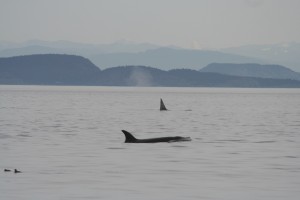
Transients traversing the San Juans
Griffin Bay to Port Townsend:
We departed San Juan Island with the intention of sailing all the way to Neah Bay, but shortly after finishing our chores, Kathryn said the word everyone was hoping to hear “whale off Starboard!”
We were able to identify Transient male #87, and think we know some of the females as well. First the male was swimming with four others, then two groups converged for a bit of exciting times, and departed once again. Overall, the transient group seemed bound to the east/southeast. They led us past Smith Island and all the way into Admiralty Inlet.
Once we were joined by two whale-watching boats the whales seemed to lighten up and give us a show. We saw plenty of tail slaps and harmonious movements, and even a spy hop and peck slap were seen. Great first day of being on the boat! The sun was out for most of the day, and the wind was gentle so we did not put up the sails.
We set up and tested the new hydrophone array. All 4 elements work and we were able to hear nearby boats, but the transients made no audible sounds during the hour or so that the array was in the water.
Read More
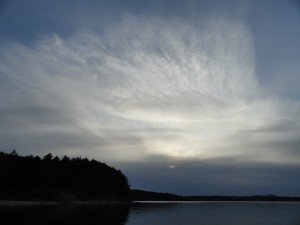
Evening sky at Griffin Bay
Hello from the Gato Verde!
Things have been going great so far — it feels wonderful to be out on the water. I have not been sailing since 2008, and the moment I set foot on the Gato Verde, every reason for loving boats I had ever conjured in my mind came rushing back to me. I actually used to have a great fear of boats. I think it began because my idea of being out at sea was based on one or two childhood whale watching experiences. During one trip, I remember being so frightened that my mom had to literally sedate me with medication. I spent most of the whale watch underneath my Little Mermaid towel, hiding from the wrath of the Massachusetts seas. Despite my dramamine-induced drowsiness, I remember my panic reached a high point once we spotted whales. Every single passenger scrambled to one side of the boat to get a better look, causing us to tip precariously (at least in my mind). In this moment I remember feeling desperately out of control of my own fate…this boat was going to sink and there was nothing I could do to stop it. Luckily, my fear of boating has gradually been replaced by a deep love of all forms of marine transportation. This is the only instance where my fear of something has decreased as I have gotten older – all my other phobias have, unfortunately, seemed to increase with time. Thankfully, the time for fear of boats has passed in my life, and I couldn’t be happier to be sailing again. Everything has been working in our favor so far weather-wise (knock on wood), and things have been going very smoothly. I even got to steer the boat for about 20 minutes yesterday!
After a relaxing first evening anchored in Griffin Bay, we rose early to get a head start on what we thought would be a very full day of sailing. We had planned to sail to Neah Bay, where there is a hydrophone in need of repair. Beam Reach has never sailed that far, so we were all looking forward to the exciting challenge of charting new territory. I woke up early after a fitful night of sleep, soothed by early-morning fog banks and loon calls. We departed on schedule and enjoyed a leisurely breakfast. Around this time, I happened to look out the window; I had seen some sea lions sunning themselves on some rocks, and I thought I might see more in the water. Instead, I saw a tall black shape sinking beneath the surface. My breath caught. No, I thought, there is absolutely no way. It’s probably just a cormorant. Then, a blow. “Whales!!†I cried, tripping over myself stupidly in an effort to get a better look. “Whales, whales!!!â€Â I clapped happily, laughing in awe – I absolutely could not believe our luck. Here we are, one day out from Friday Harbor, and we happen to stumble upon a beautiful group of transient killer whales. Their pointed dorsal fins sliced through the water, and I sighed contentedly at hearing their piercing blows. All plans of attempting a passage to Neah Bay lost, we followed the whales from nine in the morning until they gave us the slip around 3 pm. The whales came within meters of the Gato Verde several times; during one encounter I even picked up the familiar smell of whale breath on the air (which, in my opinion, smells like rotten pumpkins). I am happy to report that I recorded several videos of our time with the whales today…the quality, however, is somewhat compromised by the fact that I was leaping all over the boat in my uncontainable excitement. If these past two days have been any indication, there will be much more to report soon!
Hope everyone is well,
Kathryn
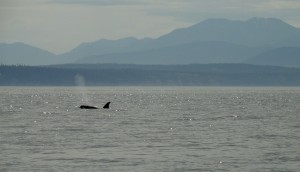
Coming up for air
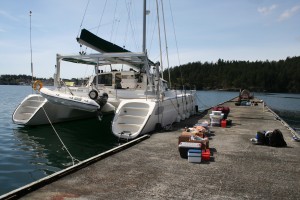
On dock before deck
FHL to Griffin Bay
We left the Labs at about 3:45 pm and used the screecher sail and motor, each taking a turn at the helm. We arrived and got an introduction to anchoring around 5:00. Because it was our first day we didn’t do any science but Jason saw a seal. We had great weather.
Read More
There was not much that went on during this week, despite the lectures, advisory meetings, and work time. It was a week of work, to prepare for the following week which would be our first week in this program out at sea!
We refined majority of our methods this week and figured out any group data that we would be able to collect to ease the process. We had talks about food consumption and how we can manage what we eat. I learned that being a meat eater that does not eat responsibly makes a huge impact, such as global warming, to our atmosphere. Localization of killer whales: now that lecture completely boggled my mind. Technology is so advanced these days that computers can estimate where a whale is located from a call produced.  Vessel regulations were also gone over in our group discussion, regarding the conservation of southern resident killer whales. Logistically, this week has been a less stressful one, but there was a lot more information to take in compared to last week’s Steller sea lion incident.
But, I cannot contain my excitement about sailing out of the labs. It will be a memorable experience to be able to go on a boat to conduct research. This first week, since the southern resident killer whales will not come up quite yet, we will be learning how to sail. We did hear some transient killer whales off of the Port Townsend hydrophone network however, so I am anticipating on catching some with my eyes out there. Sailing has so many components that I have barely touched, since I come from living in a large city. Boat terms, ocean currents, knots, and other materials will be taught to us. I feel as though this sailing week will be a good one though, since it is a chance for us to bond in a smaller environment as a group. We get to work together, socialize, cook and clean together. That way, we all get to know each other better on a personal level and help each other when needed.
From what I have heard, the Gato Verde, the boat we will be boarding and sailing on, is a 42 foot long catamaran equipped with loads of bunkbeds, bathrooms, a galley, and decks for us to go out and observe nature. With such a large boat and so few of us, I will find all the upcoming sailing weeks a pleasure! Similar to what we did on Wednesday cooking granola together at S1, I feel we’ll have so much fun!
Lastly, before I end this blog, I just wanted to mention our Cold Plunge tradition of Beam Reach. Every year, Beam Reach will require all students to jump into the waters by the dock to experience how cold the water actually is in the Pacific Northwest. Instructors follow along as well, and other students not in Beam Reach are always welcome to join. We had some students from the 3 Seas program join us this year and it was really fun. I finally got to experience the cold waters myself and I have got to say, when people say its cold, IT IS COLD.
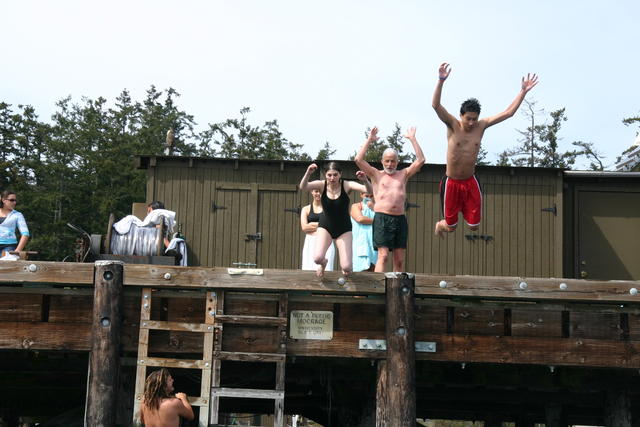
Nonetheless, I was awake for the rest of the day. You should definitely try it out.
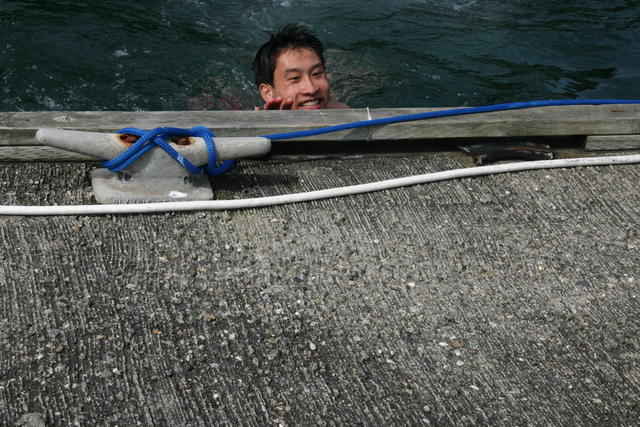
Read More
Hello, everyone!
I am finally sitting down after a long stint of packing — I had no idea I could be so inefficient at packing a single bag! We’ve all been busy buying groceries, doing laundry, and tidying up in preparation for our afternoon departure tomorrow. I am unbelievably excited to re-immerse myself in boat life (time to re-learn how to tie a bowline and start thinking about what someone means when they say “pass the jib!”). There have been reports of several large groups of transients in the area, so it is possible that we will have some orca sightings during our first leg on the Gato Verde. Other than scrambling with last-minute logistical preparations, we have not done much besides refining our research methods (and having a much-needed impromptu dance party in our spacious duplex). On Friday, we took a dip in the ocean as part of Beam Reach’s “cold plunge” experience. I had been dreading this initiation process, but it turned out to be much more enjoyable than I expected — I might even do it again! To see pictures of us freezing our buns off, click here.
Not much else to report — more to come once we’ve gotten settled into our new home. I can’t wait to brush my teeth under the stars…
Kathryn
Read More









 Twitter
Twitter LinkedIn
LinkedIn Facebook
Facebook